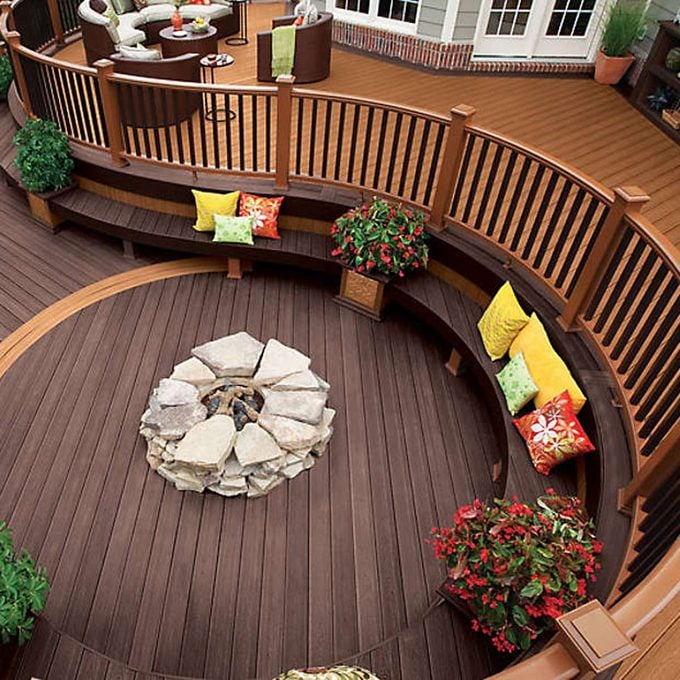Demand for environmentally friendly, virtually maintenance-free Trex composite decking grows every year. Why has this home-improvement upstart captured so much attention?
Trex Decking: Here’s What You Need to Know

Demand for environmentally friendly, virtually maintenance-free Trex composite decking grows every year. Why has this home-improvement upstart captured so much attention?
Home ownership comes with a seemingly bottomless list of maintenance tasks, so naturally home improvements that limit the ongoing investment of time and money generate a lot of buzz—particularly when they deliver on their promises and do it in an environmentally friendly way.
The Trex decking combination of ultra-low maintenance and rich finishes tends to get people talking, whether that is online or around the neighborhood. Does composite decking live up to all this enthusiasm? You may wonder about the product’s composition, installation, affordability, quality and availability. Let’s get to the bottom of these questions and what Trex composite decking can do for you and your home.
On This Page
What Is Trex Decking?
The core product for Trex Company is a wood fiber–polymer composite material which it forms into nonstructural (surface) components for construction of decks. Trex started as decking, but now manufactures a complete system for deck construction and incorporates its low-maintenance composite into a wide variety of products that complement and extend the versatility of outdoor living spaces.
Composite material never requires refinishing, does not rot, splinter or twist as it ages and resists insect damage. A tough outer shell now covers the Trex original composite core (since 2010 and the launch of Trex Transcend). This durable shell resists wear, fading and the growth of mold and mildew, while improving the cosmetic quality of the wood grain and further reducing maintenance to a simple soap-and-water process.
Trex composite decking also does some things that wood can’t. Trex fasteners go in between deck boards, keeping the walking surface smooth and unblemished. Do you like curves? Trex Customcurve allows deck designs to incorporate dramatic, sweeping arcs and wraparounds.
Best of all, the manufacturing process of the Trex composite consumes 95-percent recycled materials. At one point, the company claimed that it was consuming as much as half of all available recycled plastic film in the United States. In the period between 2007 and 2012, the company kept more than 2.5 billion pounds of plastic and wood scrap out of landfills. A typical 500-square-foot deck contains 140,000 recycled plastic bags.
The History of Trex Decking
Chemist and entrepreneur, Roger Wittenberg, has made a career of transforming waste streams into revenue steams. During the 1980s, his enterprise manufacturing chicken feed from bakery leftovers led to selling breadcrumbs made from waste loaves. Although the breadcrumb biz was a money-maker, it did have its challenges, according to an interview he gave to Fortune Small Business in 2003. Using cheap, excess bread for his raw material left him with thousands of empty plastic bread bags each day. Solving the challenge of that waste stream eventually led to Trex.
By1988, Wittenberg had found a way to bind a composite made from two waste products: plastic film (largely grocery bags collected for recycling) and wood scrap, such as sawdust and tailings from furniture manufacturing. In 1992, Mobil Oil bought the technology. At the time, Mobile Oil owned Hefty bags and was the largest plastics producer in America. Later, the Exxon/Mobil merger led to divestment of the company’s plastics division, but not before it identified decking as the target market for Wittenberg’s composite wood substitute. In 1996, Wittenberg and a team of investors acquired Trex and the current company was born.
Now publicly traded (NYSE: TREX), the company leads North America in market share, reporting annual sales of $560 million and distribution to 40 countries. In addition to creating new uses for its composite material, Trex has acquired manufacturing and technology (2011) to complete a low-maintenance deck-building system and launched its Trex Elevations line of steel structural components for decks.
Other notable expansion of the Trex brand includes: Trex Transcend line (2010), deck lighting (2010), Trex Enhance line (2012), Trex Select line (2013), Trex Reveal aluminum railings (2013), aluminum gates (2014) and Trex Signature Railing (2017).
Best Uses for Trex Decking
Because the composite material at the core of Trex products does not stand up to structural loads, its best use is for surface applications, the most obvious being deck surfaces. Product development has focused on improving cosmetic performance with more realistic wood grain, the ability to take more abuse from foot traffic and better protection from sun exposure and spill stains. However, Trex can be made into benches, planters, yard games, outdoor furniture, shelves, and more based on your imagination. Just keep in mind that its design carries a body-weight load across the span of 12 to 16 inches, and a typical deck is designed to support 40 pounds per square foot.
Is Trex Decking for DIYers?
Although the recommended installation of Trex uses a proprietary hidden fastener system, the product is DIY-friendly and the company offers resources that walk you through the process from estimating, design and ordering to site preparation and installation. The company’s website offers a series of video tutorials and downloadable PDF files that illustrate every aspect of construction.
How Much Does Trex Decking Cost?
Comparing the cost of Trex to wood, the Trex Enhance Basics line is designed to compete with the cost of pressure-treated wood decking and scales up from there. Trex notes, however, that the higher initial investment at installation eliminates the cost and effort required to keep up a wood deck on an annual basis. In the long run, a Trex deck has the potential to save you money.
Where Can You Buy Trex Decking?
Find a limited selection of Trex decking off-the-shelf at The Home Depot and Lowe’s. Special ordering offers a wider selection. To access the full Trex product line, contact a local lumber yard (the Trex site has a dealer locator).




















